FRIDAY'S SCRIPT TIP:
HOW DOES IT PLAY?
We all hope that our scripts will eventually end up on screen. That our words will be
spoken by actors and our images in our imagination will be realized in Technicolor.
For most pre-pros, writing is theoretical rather than practical. The story is anchored in
our imagination with little or no thought to how it might work in the real world... and
that can be a problem.

Dialogue that plays on the page may not "play on the stage". This is often true with
dialogue that looks fine... but becomes clumsy when spoken aloud. If possible, you
should always try out your dialogue with a reading of some sort. Playwright Sam
Shepard says, "A good actor always sets you straight. If you've written a false moment
and thought it was probably pretty great, the actor's gonna show you (whether it it's
great or not) when he gets to that moment. They are the great test of the validity of
material." Contact a community theater group in your area, or draft a group of fellow
screenwriters. Listen to how your dialogue really sounds, and identify any problems
while you're still in the script stage. The higher your script moves up the ladder of
production, the more likely it will encounter someone who knows how it will play on
screen. Readers often have no experience with how a script will play on screen, but
directors and producers know what works... and what doesn't. Eventually those lines
that won't work on screen will be discovered, so let's try to solve the problem before
anyone notices it exists.
Here are some common dialogue problems that only appear when the script goes to
screen.
1) Long sentences that don't provide any place for an actor to breathe.
2) Tongue twisters or lines with similar sounding words that might be transposed by
an actor.
3) Word combinations that accidentally form puns - If a character in a bathroom says
"You're in!" the audience may misunderstand. Some sentences look perfectly innocent
on the page, but when you read them out loud they provoke laughter.
4) Homonyms back-to-back like "They're there!" Anytime you have two words that
sound the same in a row... or even the same word back-to-back in a sentence, you
have a problem.
5) Multi syllable words that just don't fit in an actor's mouth like, well, mutisyllabic. Similar to
tongue twisters, these words are easy for an actor to trip over.
6) Words that create facial expressions at odds with their meaning. This is one that
you may miss in a reading. I had a story meeting on one of my scripts where the devo
wanted me to change a line of dialogue. My lead character didn't want to get involved
in a situation where he might be killed and said, "It looks dangerous." The devo
wanted me to change the line to: "It looks risky." She didn't understand that when you
say the word "risky" you smile... and a smile would change the meaning of the line.
Instead of the lead being afraid, he would end up looking as if he were happy to walk
into danger. She didn't understand what I was talking about until she said the line
while looking in a mirror... and realized she looked HAPPY to be risking her life!
7) One sided conversations where the other person just stands there. That may look
okay on the page, but on screen that other actor has nothing to do.
You want to make sure that dialogue that looks great on the page can be spoken by an actor, and *works* when spoken by an actor.
DO THE VISUALS PLAY?

Part of our job, and the reader's job, is to *imagine* the story playing on the screen... and the visual portion is something that you can't really get in a staged reading - yet is the most important element in a visual medium like film. We need to imagine what will be seen on screen while writing our screenplay, and *know* what can and can not be seen on screen and consider what the best images to tell our story will be. This is not directing on the page, it is thinking about how what we write will be seen on screen. Some scenes that seem great on the page may not work at all on screen.
Let's say you have a story where a couple who are deeply in love get torn apart by the circumstances of the conflict, so you want to establish their love at the beginning of the script. You decide to show them calling each other from work during the day - a great way to show that they do not like being apart, right? But what does that look like on screen? That great phone conversation? Instead of showing your couple together, it will show them apart! They will be in separate shots, never shown on screen at the same time - as if they are different people and *not* a couple. There can be no "two shot" of people having a phone conversation. But wait, you say, what if the director uses a split screen so that they can both be on screen at the same time? Well, there will be a giant bar coming between them that splits the screen - which may even be worse that two different shots! Now you have a visual that *shows* something is always between them. That *shows* they are not together at all. On the page this phone conversation can be a great scene, on the screen we give the audience the subconscious message that these two are only pretending to be a couple when they are really two separate people. The better scene is one where they can be in the same frame, in the same shot. A scene at home before work where they can actually touch each other and actually be together. You want to think about how the visuals will play - some things work on the page but don't work on the screen at all!
DOESN'T PLAY ON THE PAGE

There are also things that work great on screen, but not so great on the page. Since the only purpose of a screenplay is to become a movie, or show that you have the writing skills to be hired for an assignment that will become a movie, what is most important is what works on screen rather than what works on the page. We are *screen*writers, not *page*writers, so the most important thing is how what we write will work on that screen.
The famous Hitchcock example of suspense is the two guys discussing baseball statistics while a time bomb ticks away under their table. They don't discuss something exciting and important, they discuss *baseball statistics* - probably the most boring subject in the world. As I pointed out in my blog entry on suspense and dread in the film THE LEOPARD MAN, one of the critical elements in the dramatic irony that builds suspense in this situation is that the more boring and mundane the conversation as the seconds tick away, the *more suspense on screen*. If the characters are discussing something important, they are *not* just wasting their time as a bomb ticks away under the table. But if they are discussing something completely trivial and completely unimportant, the suspense is ramped up because they are doing something pointless as the bomb ticks away under the table. Unfortunately, a bunch of pointless and mundane dialogue may look like filler material on the page. Readers who skip the action or don't see how it will appear on screen may think this dialogue can be cut, or replaced with something more interesting... and while that may play better on the page, we are not writing novels - we are writing *movies*. And that means we must write what plays best on screen... even if it does not play well on the page. The key here is to be brief with the boring stuff. Here's an example from THREE DAYS OF THE CONDOR - the elevator scene where bookworm Turner is trapped on an elevator with assassin Joubert and tension builds with every moment they are together...
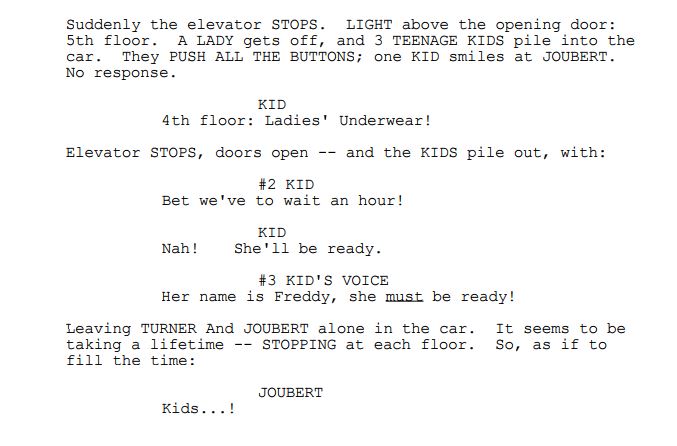
In the filmed version there is more boring small talk (gloves, grandpa's birthday cake, lots of other mundane things) but this section of the script introduces the idea of mundane conversation in the the elevator to heighten the suspense. Leaving it out, or making the conversation interesting, would kill the suspense on screen, even if it improved the read. So we *need* to establish that there will be boring conversation that has nothing to do with Turner and the Assassin trapped on the elevator. Unexciting dialogue.
If we wrote a scene that plays great on the page but would not work on screen, and that got us an assignment; we would just be continuing that bad habit in a script that actually will be filmed. Which is one of the ways bad movies come to be. Though we have no control over readers or development executives who skip or skim on a script (except writing riveting stuff) or executives who lack the imagination to see what will end up on the screen; doing our job wrong will not change anything. The solution here is to take those executes out to the Hollywood city limits and tell them not to come back. That's not our job, either, by the way. But I would hope an executive who wanted dialogue that played on the page but would screw up the scene could see your point if you discussed this note with them.

There are other things that play well on the page but don't play well on screen at all. Some things that we can read might be repulsive to see. This happens sometimes in comedies, where a joke that works in our imagination just becomes gross when the elements are shown on screen. It's better to be outside the stall when explosive diarrhea strikes in DUMB & DUMBER and just hear the sounds. This is also true in horror movies - sometimes we are better off in the next room imagining what is happening.
Part of our job is to think through what we write on the page, all the way to the screen. To imagine what it looks like up there in front of the audience and make sure what we write will work once the film is made. Developing the skills to know what will play, whether it is dialogue or visuals, is critical to the screenplays we write that actually do become movies. When someone in your screenplay says "You're in!" you don't want the audience to think the character has just stepped in a suspicious puddle in the restroom.
A script that reads great on the page but creates problems when you actually make
it into film defeats its very purpose. A screenplay isn't theoretical, it is a precision
crafted component of a motion picture. A screenplay exists to be made into a film.
Your lines of dialogue have to work on the page AND on "the stage".
BRAND NEW!
How Do I do That?

101 SCREENWRITING ANSWERS Blue Book!
New to screenwriting? You probably have questions! How do I get an Agent? How do I write a phone conversation? Do I need a Mentor? What’s does VO and OC and OS mean? What is proper screenplay format? Should I use a pen name? Do I need to movie to Hollywood? What’s the difference between a Producer and a Production Manager, and which should I sell my script to? How do I write a Text Message? Should I Copyright or WGA register my script? Can I Direct or Star? How do I write an Improvised scene? Overcoming Writer’s Block? How do I write a Sex Scene? And many many more! This book has the answers to the 101 Most Asked Questions from new screenwriters! Everything you need to know to begin writing your screenplay!
All of the answers you need to know, from a working professional screenwriter with 20 produced films and a new movie made for a major streaming service in 2023!
Only $4.99
NEW!!!
Can You Make It bigger?

BLOCKBUSTERS (and BEACH READS) Blue Book!
Writing something EPIC?
Over 500 Pages, ONLY : $4.99!
Thinking about writing a big Disaster Movie? An Historical Epic? An Epic Adventure Film? Or maybe you like Gladiator Movies? This book looks at writing Blockbusters and those Big Fat Beach Read novels - anything epic! Usng movies like JAWS, POSEIDON ADVENTURE, LAWRENCE OF ARABIA, THE GUNS OF NAVARONE, and those MARVEL and FAST & FURIOUS flicks as examples. What *is* a Blockbuster? 107 years of Blockbuster history! Blockbuster Characters. Blockbuster Story Types! Why modern Blockbusters are soap operas! Social Issues in Blcokbusters? Big Emotions! Keeping All Of Those Characters Distinctive! How to avoid the Big problems found in Big Movies and books! More! If you are writing a Big Event Movie or a Big Fat Novel, there are tips and techniques to help you!
Only $4.99
NEW!!
All About Endings!
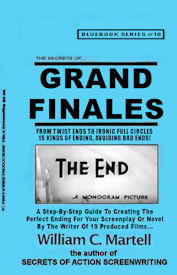
GRAND FINALES Blue Book!
The Perfect Ending For Your Story!
The First Ten Pages Of Your Screenplay Are Critical,
But What About The Last 10 Pages?
Creating the perfect ending to your story! This 100,000 word book shows you how to end your story with a bang, rather than a whimper. Everything from Resolution Order to Act Three Tools to Happy or Sad Endings? to How The Beginning Of Your Story Has Clues To The Ending (in case you were having trouble figuring out how the story should end) to Falling Action to How To Avoid Bad Endings to Writing The Perfect Twist Ending to Setting Up Sequels & Series to Emotional Resolutions to How To Write Post Credit Sequences to Avoiding Deus Ex Machinas, to 20 Different Types Of Ends (and how to write them) and much more! Everything about endings for your screenplay or novel!
Only$4.99
BRAND NEW
All About LOGLINES, TREATMENTS, and PITCHING!

LOGLINES, TREATMENTS, and PITCHING! Blue Book!
Distilling Your Screenplay!
Loglines, Treatments, Pitching, Look Books, Pitch Decks, One Pagers, Rip-O-Matics?
You have written a brilliant 110 page screenplay, but how do you get anyone to read it? You need to distill it down into some form of verbal moonshine or story rocket fuel that will ignite that bored development executive or manager or agent and get them to request your screenplay. But how do you shrink those 110 pages into a 25 word logline or a 2 minute elevator pitch or a one page synopsis or a short paragraph? This 100,000 word book shows you how! Everything you need to know! From common logline mistakes (and how to solve them) to how your pitch can reveal story problems to the 4 types of pitches!
272 pages - ONLY $4.99!
NEW: WRITE IT: FILM IT!

Making Your Own Movie?
Writing An Indie Film?
Writing A Low Budget Genre Script To Sell?
Writing A Made For TV Holiday Movie?
You will be writing for BUDGET. On a standard spec screenplay, you don’t have to think about budget, but these types of screenplays writing with budget in mind is critical!
If you are making your own movie, budget, is even more important - and you need to think about budget *before* you write your screenplay... or you will end up with a script that you can’t afford to make (or is a struggle to make). Everyone is making their own films these days, and even if you have done it before there are lots of great techniques in this book to get more money on screen - for less money! You can make a film that looks like it cost millions for pocket change.
344 pages - SALE:: $7.99!
NEW!

THE MISSION IMPOSSIBLE MOVIES
NEW: Updates On Films 7 & 8 Casting!
All Six Movies analyzed! All of the mission tapes, all of the “that’s impossible!” set pieces and stunts, the cons and capers - and how these scenes work, the twists and double crosses, the tension and suspense (and how to generate it), the concept of each film as a stand alone with a different director calling the shots (broken in the sixth film), the gadgets, the masks, the stories, the co-stars and team members (one team member has been in every film), the stunts Tom Cruise actually did (and the ones he didn’t), and so much more! Over 120,000 words of fun info!
THE MISSION IMPOSSIBLE MOVIES - 347 pages - Only $3.99 !
NO KINDLE REQUIRED! Get the *free* app (any device, except your Mr. Coffee) on the order page on Amazon!

BRAND NEW!
*** THE BOURNE MOVIES
All five "Bourne" movies (including "Legacy" and it's potential sequels) - what are the techniques used to keep the characters and scenes exciting and involving? Reinventing the thriller genre...
or following the "formula"? Five films - each with an interesting experiment! A detailed analysis of each
of the films, the way these thrillers work... as well as a complete list of box office and critical
statistics for each film. This book is great for writers, directors, and just fans of the series.
268 pages - Only $3.99
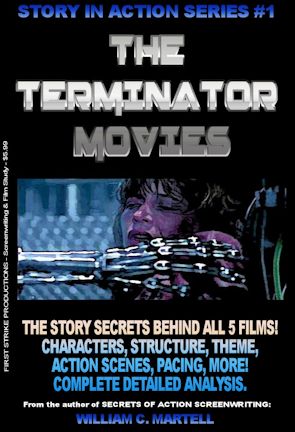
Over 240 pages!
*** THE TERMINATOR MOVIES *** - For Kindle!
He's back! The release of "Terminator: Dark Fate" is set to begin a new trilogy in
the Terminator story... 35 years after the first film was released. What draws us to these films about
a cybernetic organism from the future sent back in time? Why is there a new proposed trilogy every few
years? This book looks at all five Terminator movies from a story standpoint - what makes them work
(or not)? What are the techniques used to keep the characters and scenes exciting and involving? How
about those secret story details you may not have noticed? Containing a detailed analysis of each of
the five films so far, this book delves into the way these stories work... as well as a complete list of
box office and critical statistics for each film. This book is great for writers, directors, and just
fans of the series.
ONLY $3.99 - and no postage!
Tips FAQ

My New Script Secrets Newsletter!

NEW BOOKS!
BRAND NEW
OUTLINES & THE THEMATIC!
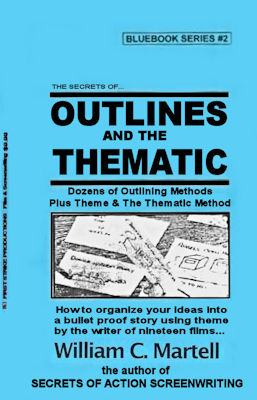
OUTLINES & THE THEMATIC Blue Book.
ARE YOUR SCENES IN THE RIGHT ORDER?
AND ARE THEY THE RIGHT SCENES?
Your story is like a road trip... but where are you going? What's the best route to get there? What are the best sights to see along the way? Just as you plan a vacation instead of just jump in the car and start driving, it's a good idea to plan your story. An artist does sketches before breaking out the oils, so why shouldn't a writer do the same? This Blue Book looks at various outlining methods used by professional screenwriters like Wesley Strick, Paul Schrader, John August, and others... as well as a guest chapter on novel outlines. Plus a whole section on the Thematic Method of generating scenes and characters and other elements that will be part of your outline. The three stages of writing are: Pre-writing, Writing, and Rewriting... this book looks at that first stage and how to use it to improve your screenplays and novels.
Only $4.99!
ALSO NEW!
DESCRIPTION & VOICE Blue Book!
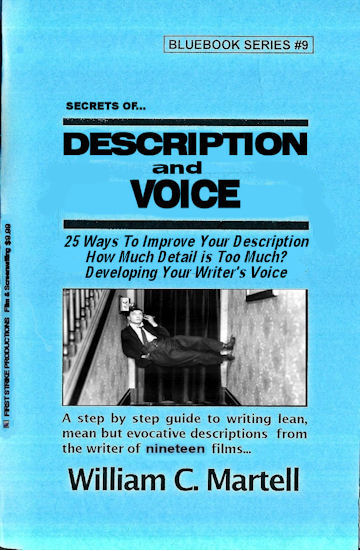
DESCRIPTION & VOICE Blue Book.
IS HALF OF YOUR STORY IN TROUBLE?
Most screenplays are about a 50/50 split between dialogue and description - which means your description is just as important as your dialogue. It just gets less press because the audience never sees it, the same reason why screenwriters get less press than movie stars. But your story will never get to the audience until readers and development executives read your script... so it is a very important factor. Until the movie is made the screenplay is the movie and must be just as exciting as the movie. So how do you make your screenplay exciting to read? Description is important in a novel as well, and the “audience” does read it... how do we write riveting description?
Only $4.99!
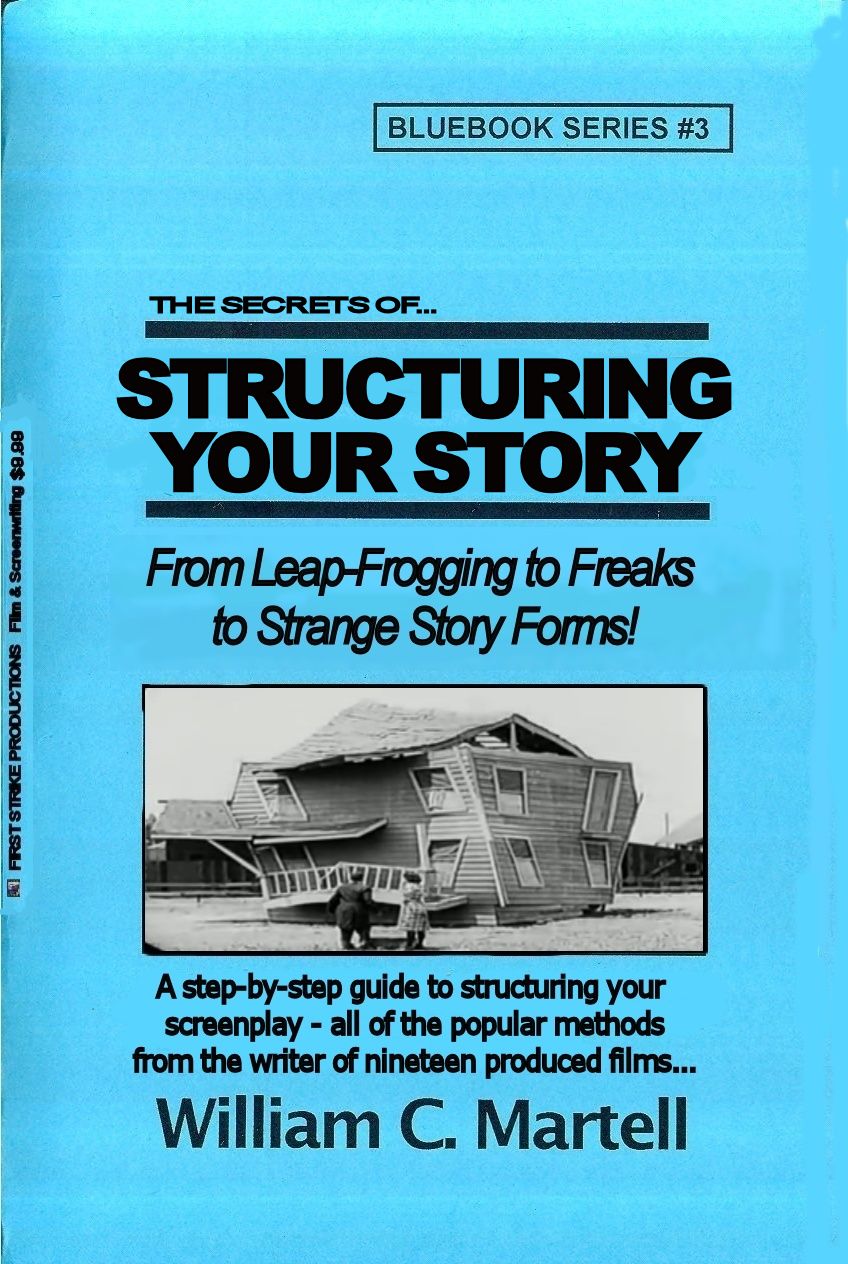
NEW AND HOT!
*** STRUCTURING YOUR STORY *** - For Kindle!
William Goldman says the most important single element of any screenplay is structure. It’s the skeleton under the flesh and blood of your story. Without it, you have a spineless, formless, mess... a slug! How do you make sure your structure is strong enough to support your story? How do you prevent your story from becoming a slug? This Blue Book explores different types of popular structures from the basic three act structure to more obscure methods like leap-frogging. We also look at structure as a verb as well as a noun, and techniques for structuring your story for maximum emotional impact. Most of the other books just look at *structure* and ignore the art of *structuring* your story. Techniques to make your story a page turner... instead of a slug!
Only $4.99 - and no postage!
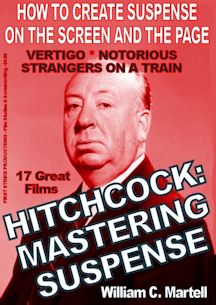
LEARN SUSPENSE FROM THE MASTER!
*** HITCHCOCK: MASTERING SUSPENSE *** - For Kindle!
Alfred Hitchcock, who directed 52 movies, was known as the *Master Of Suspense*; but what exactly is suspense and how can *we* master it? How does suspense work? How can *we* create “Hitchcockian” suspense scenes in our screenplays, novels, stories and films?
This book uses seventeen of Hitchcock’s films to show the difference between suspense and surprise, how to use “focus objects” to create suspense, the 20 iconic suspense scenes and situations, how plot twists work, using secrets for suspense, how to use Dread (the cousin of suspense) in horror stories, and dozens of other amazing storytelling lessons. From classics like “Strangers On A Train” and “The Birds” and “Vertigo” and “To Catch A Thief” to older films from the British period like “The 39 Steps” and “The Man Who Knew Too Much” to his hits from the silent era like “The Lodger” (about Jack The Ripper), we’ll look at all of the techniques to create suspense!
Only $5.99

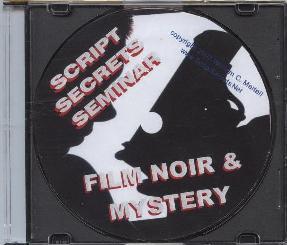
AUDIO CLASS!
NOIR & MYSTERY80 minute MP3 packed with information on writing Film Noir and Mystery scripts. Using examples from CHINATOWN to OUT OF THE PAST to DOUBLE INDEMNITY you'll learn how to create stories in this dark, twisted genre. How to plant clues, red herrings, suspects, victims, spider women, fallen heroes, the funhouse mirror world of noir supporting characters... and the origins of Film Noir in literature Noir dialogue and how noir endings are different than any other genre. All of the critical elements necessary to write in this critically popular genre.
The Noir & Mystery Class is only $15 (plus $5 S&H). First 20 on Limited Black Disk!
RECESSION SALE! $5 OFF!
IDEAS AND CREATIVITY - 80 minute MP3 packed with information. Tools to find ideas that are both personal *and* commercial. Hollywood wants scripts with High Concept stories... but not stupid scripts. Developing *intelligent* high concept ideas. How to turn your personal story into a blockbuster - or find your personal story in a high concept idea. Brainstorming and being creative. Ideas and Creativity is $10.00 (plus $5 S&H)
WRITING INDIES - Writing an Indie film? This class covers everything you need to know - from Central Locations to Confined Cameos. Using examples from SWINGERS, THE COOLER, STATION AGENT and others, this 80 minute MP3 is packed with information. How Indoe films challenge the audience (while mainstream films reassure the audience). Structures, using BOYS DON'T CRY, RUN LOLA RUN, HILARY & JACKIE, and others as example. Writing for a budget, writing for non-actors, getting the most production value out of your budget. Writing Indies is $10.00 (plus $5 S&H)
WRITING HORROR - The essentials of a horror screenplay - what do ROSEMARY'S BABY, NIGHT OF THE LIVING DEAD, THE EXORCIST, BRIDE OF FRANKENSTEIN, THE OTHERS and OPEN WATER have in common? This class will tell you! All of the critical elements necessary to write a script that scares the pants off the audience. Writing Horror is $10.00 (plus $5 S&H).
Click here for more information on CLASS MP3s!
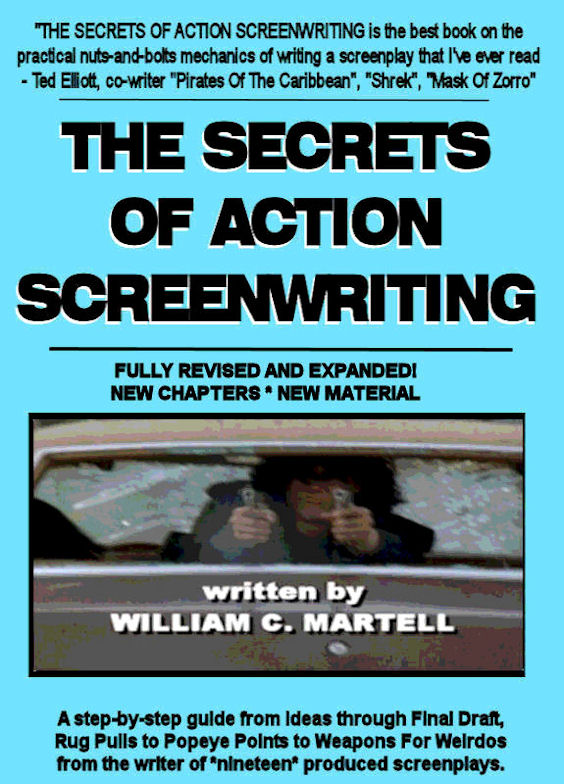
THE BOOK THAT STARTED IT ALL!
*** THE SECRETS OF ACTION SCREENWRITING *** - For Kindle!
*** THE SECRETS OF ACTION SCREENWRITING *** - For Nook!
Why pay $510 for a used version of the 240 page 2000 version that used to retail for $21.95? (check it out!) when
you can get the NEW EXPANDED VERSION - over 500 pages - for just $9.99? New chapters, New examples, New techniques!
"SECRETS OF ACTION SCREENWRITING is the
best book on the practical nuts-and-bolts mechanics of writing a screenplay I've ever read."
- Ted Elliott, co-writer of MASK OF ZORRO, SHREK, PIRATES OF THE CARIBBEAN and the sequels (with Terry Rossio). (ie; 4 of the top 20 Box Office Hits Of ALL TIME.)
Only $9.99 - and no postage!
READY TO BREAK IN?
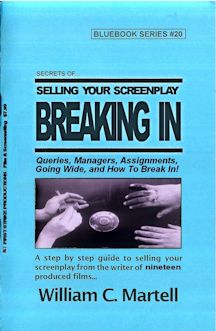
NEW!
*** BREAKING IN BLUE BOOK *** - For Kindle!
Should really be called the BUSINESS BLUE BOOK because it covers almost everything you will need to
know for your screenwriting career: from thinking like a producer and learning to speak their language,
to query letters and finding a manager or agent, to making connections (at home and in Hollywood) and
networking, to the different kinds of meetings you are will have at Studios, to the difference between
a producer and a studio, to landing an assignment at that meeting and what is required of you when you
are working under contract, to contracts and options and lawyers and... when to run from a deal!
Information you can use *now* to move your career forward! It's all here in the Biggest Blue Book yet!
Print version was 48 pages, Kindle version is over 400 pages!
$4.99 - and no postage!
NO KINDLE REQUIRED! Get the *free* app (any device, except your Mr. Coffee) on the order page on Amazon!
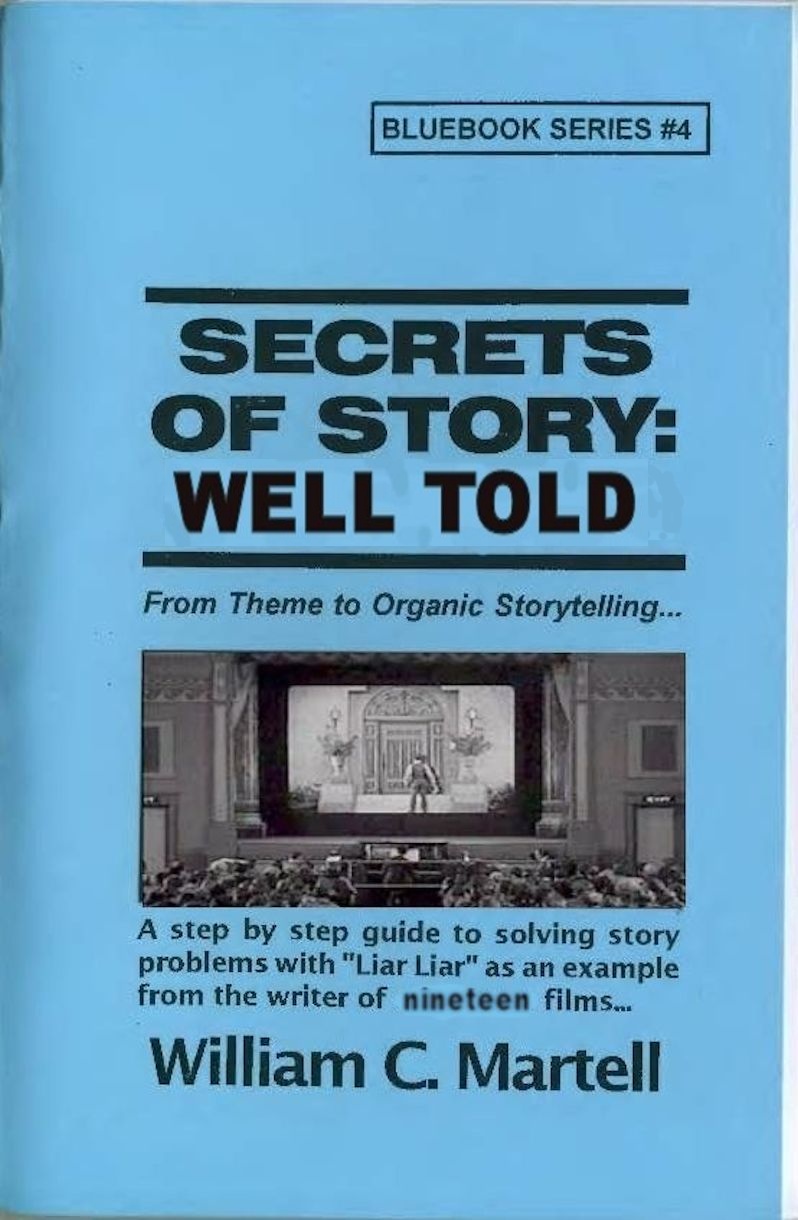
STORY: WELL TOLD!
*** STORY: WELL TOLD *** - For Kindle!
This book takes you step-by-step through the construction of a story... and how to tell a story well, why Story always starts with character... but ISN'T character, Breaking Your Story, Irony, Planting Information, Evolving Story, Leaving No Dramatic Stone Unturned, The Three Greek Unities, The Importance Of Stakes, The Thematic Method, and how to create personal stories with blockbuster potential. Ready to tell a story?
Print version was 48 pages, Kindle version is over 85,000 words - 251 pages!
Only $4.99 - and no postage!
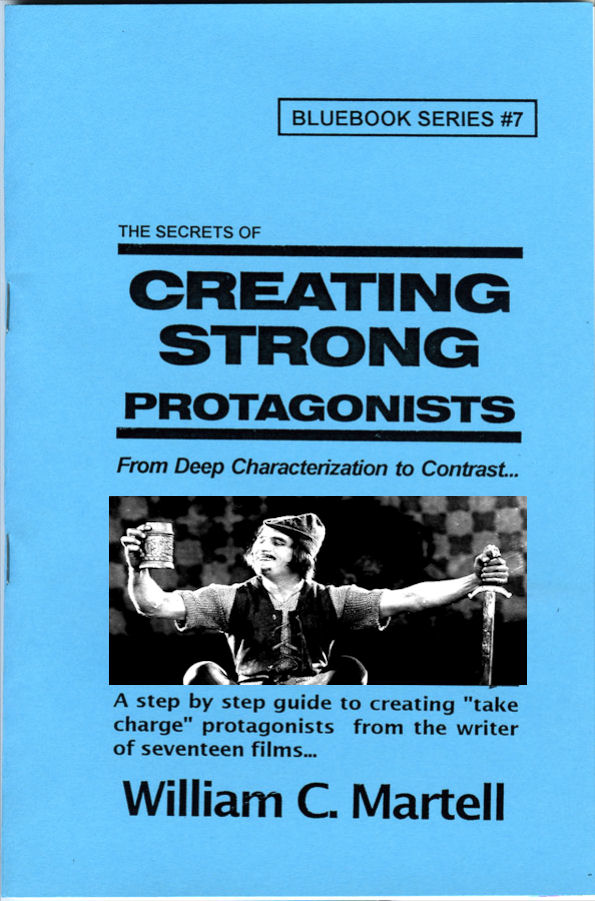
MOVIES ARE CHARACTERS!
*** CREATING STRONG PROTAGONISTS *** - For Kindle!
*** CREATING STRONG PROTAGONISTS *** - For Nook!
Expanded version with more ways to create interesting protagonists! A step-by-step guide to creating "take charge" protagonists. Screenplays are about characters in conflict... characters in emotional turmoil... Strong three dimensional protagonists who can find solutions to their problems in 110 pages. But how do you create characters like this? How do you turn words into flesh and blood? Character issues, Knowing Who Is The Boss, Tapping into YOUR fears, The Naked Character, Pulp Friction, Man With A Plan, Character Arcs, Avoiding Cliche People, Deep Characterization, Problem Protagonists, 12 Ways To Create Likable Protagonists (even if they are criminals), Active vs. Reactive, The Third Dimension In Character, Relationships, Ensemble Scripts, and much, much more. Print version is 48 pages, Kindle version is once again around 205 pages!
ONLY $4.99 - and no postage!
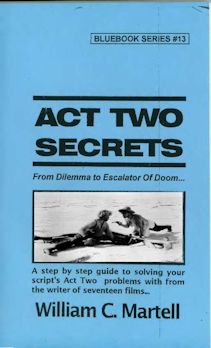
ACT TWO SOLUTIONS!
*** ACT TWO SECRETS *** - For Kindle!
Expanded version with more techniques to help you through the desert of Act Two! Subjects Include: What Is Act Two? Inside Moves, The 2 Ps: Purpose & Pacing, The 4Ds: Dilemma, Denial, Drama and Decision, Momentum, the Two Act Twos, Subplot Prisms, Deadlines, Drive, Levels Of Conflict, Escalation, When Act Two Begins and When Act Two Ends, Scene Order, Bite Sized Pieces, Common Act Two Issues, Plot Devices For Act Two, and dozens of others. Over 67,000 words (that’s well over 200 pages) of tools and techniques to get you through the desert of Act Two alive!
Print version was 48 pages, Kindle version is well over 200 pages!
ONLY $4.99 - and no postage!
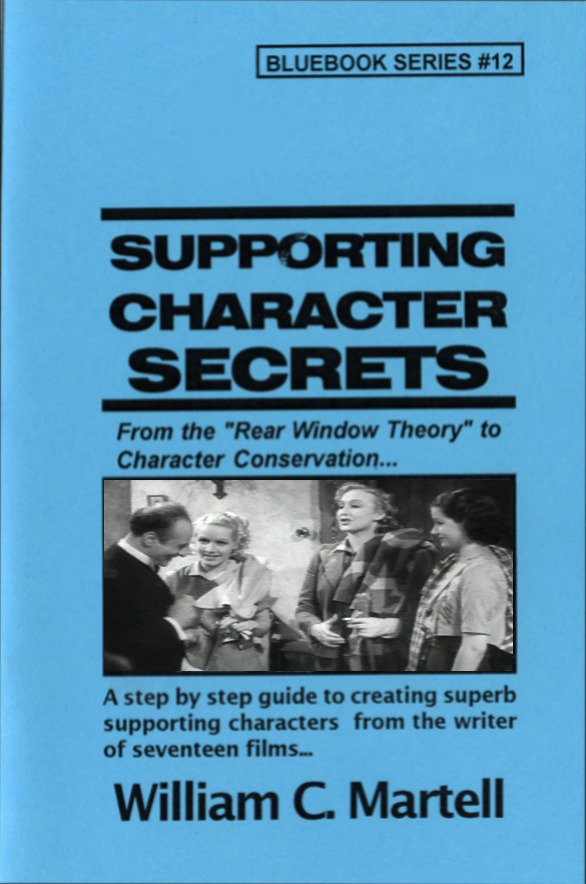
SUBPLOTS?
*** SUPPORTING CHARACTER SECRETS *** - For Kindle! (Exclusive)
Expanded version with more techniques to flesh out your Supporting Characters and make them individuals. Using the hit movie BRIDESMAIDS as well as other comedies like THE HANGOVER and TED and HIGH FIDELITY and
40 YEAR OLD VIRGIN and many other examples we look at ways to make your Supporting Characters come alive on the page.
Print version was 48 pages, Kindle version is around 170 pages!
ONLY $4.99 - and no postage!

ADVICE FROM 1920!
*** VINTAGE #1: HOW TO WRITE PHOTOPLAYS *** - For Kindle!
***
Screenwriting books have been around as long as films have. This series reprints vintage screenwriting books with a new introduction and history, plus new articles which look at how these lessons from almost 100 years ago apply to today’s screenplays. Anita Loos book is filled with information which still applies.
In addition to the full text of the original book, you get the full screenplay to Miss Loos' hit THE LOVE EXPERT, plus several new articles on the time period and women in Hollywood.
ONLY $2.99 - and no postage!
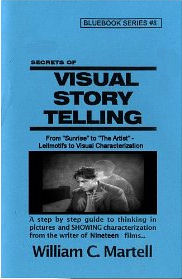
I WRITE PICTURES!
*** VISUAL STORYTELLING *** - For Kindle! (exclusive)
Show Don't Tell - but *how* do you do that? Here are techniques to tell stories visually! Using Oscar Winning Films and Oscar Nominated Films as our primary examples: from the first Best Picture Winner "Sunrise" (1927) to the Oscar Nominated "The Artist" (which takes place in 1927) with stops along the way Pixar's "Up" and Best Original Screenplay Winner "Breaking Away" (a small indie style drama - told visually) as well as "Witness" and other Oscar Winners as examples... plus RISE OF THE PLANET OF THE APES. Print version is 48 pages, Kindle version is over 200 pages!
ONLY $4.99 - and no postage!
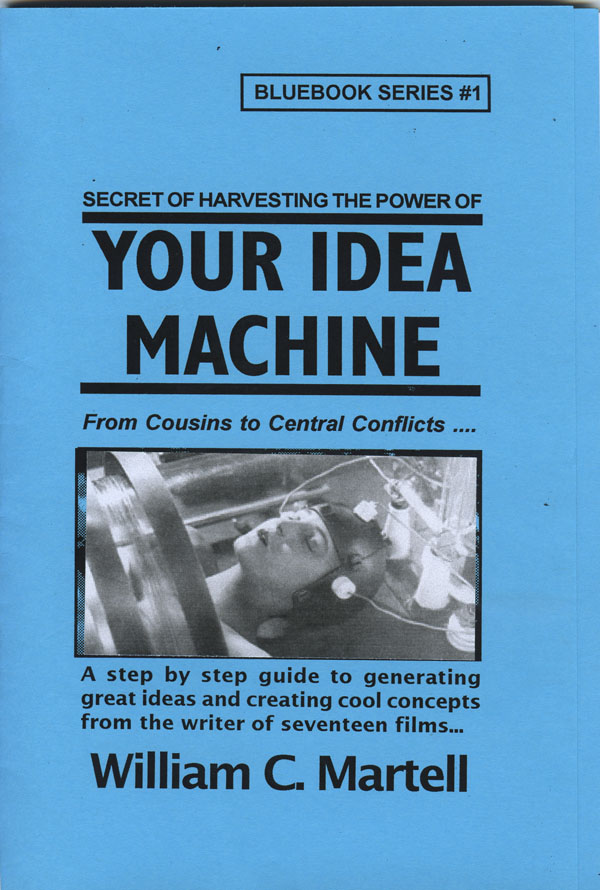
BEST SELLER!
*** YOUR IDEA MACHINE *** - For Kindle!
*** YOUR IDEA MACHINE *** - For Nook!
Expanded version with more ways to find great ideas! Your screenplay is going to begin with an idea. There are good ideas and bad ideas and commercial ideas and personal ideas. But where do you find ideas in the first place? This handbook explores different methods for finding or generating ideas, and combining those ideas into concepts that sell. The Idea Bank, Fifteen Places To Find Ideas, Good Ideas And Bad Ideas, Ideas From Locations And Elements, Keeping Track Of Your Ideas, Idea Theft - What Can You Do? Weird Ways To Connect Ideas, Combing Ideas To Create Concepts, High Concepts - What Are They? Creating The Killer Concept, Substitution - Lion Tamers & Hitmen, Creating Blockbuster Concepts, Magnification And The Matrix, Conflict Within Concept, Concepts With Visual Conflict, Avoiding Episodic Concepts, much more! Print version is 48 pages, Kindle version is over 175 pages!
Only $4.99 - and no postage!
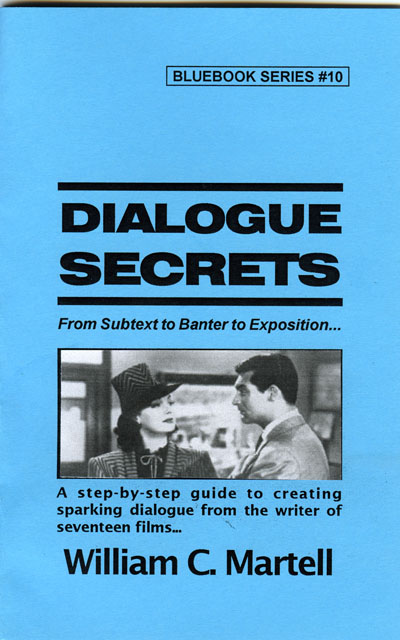
PRO DIALOGUE TECHNIQUES!
*** DIALOGUE SECRETS *** - For Kindle!
*** DIALOGUE SECRETS *** - For Nook!
Expanded version with more ways to create interesting dialogue! How to remove bad dialogue (and what *is* bad dialogue), First Hand Dialogue, Awful Exposition, Realism, 50 Professional Dialogue Techniques you can use *today*, Subtext, Subtitles, Humor, Sizzling Banter, *Anti-Dialogue*, Speeches, and more. Tools you can use to make your dialogue sizzle! Special sections that use dialogue examples from movies as diverse as "Bringing Up Baby", "Psycho", "Double Indemnity", "Notorious", the Oscar nominated "You Can Count On Me", "His Girl Friday", and many more! Print version is 48 pages, Kindle version is over 175 pages!
Only $4.99 - and no postage!

Use your creative energy to focus on the content; let Final Draft take care of the style. Final Draft is the number-one selling application specifically designed for writing movie scripts, television episodics and stage plays. Its ease-of-use and time-saving features have attracted writers for almost two decades positioning Final Draft as the Professional Screenwriters Choice. Final Draft power users include Academy, Emmy and BAFTA award winning writers like Oliver Stone, Tom Hanks, Alan Ball, J.J. Abrams, James Cameron and more.
* * * Buy It!

|

